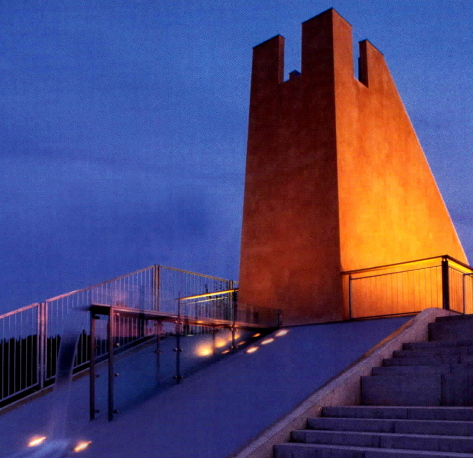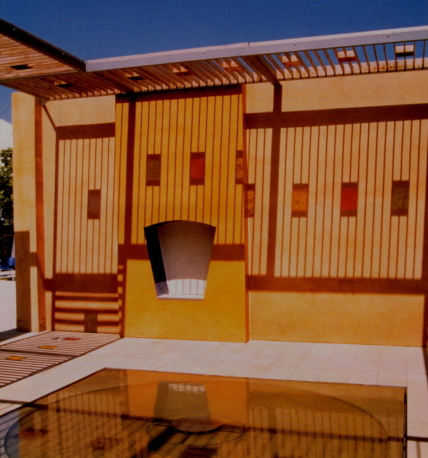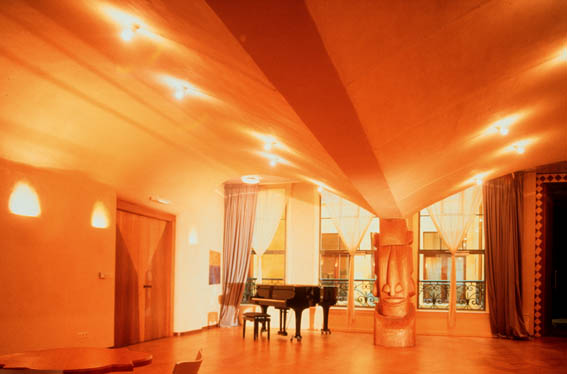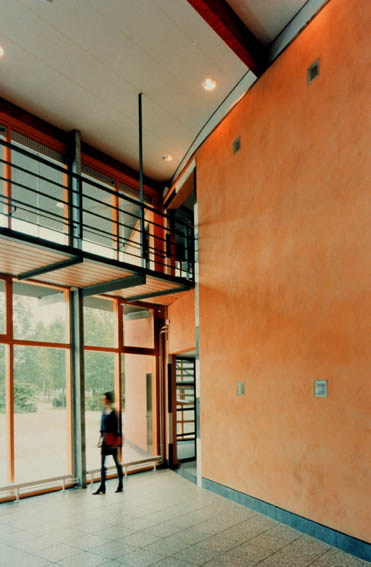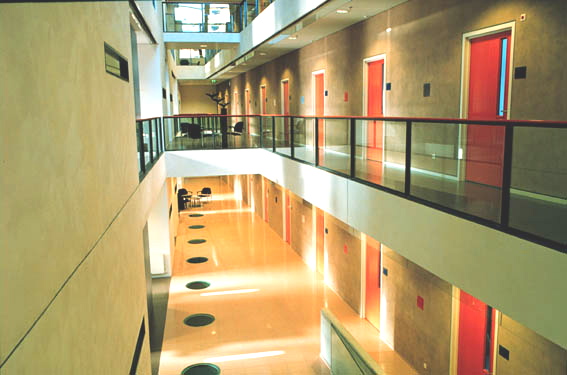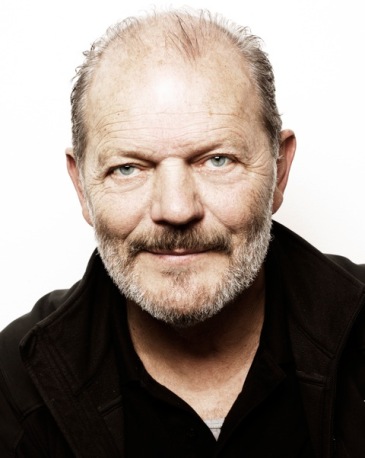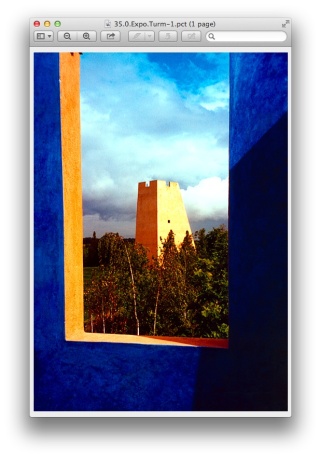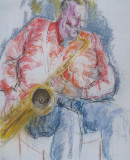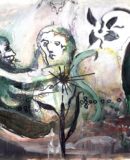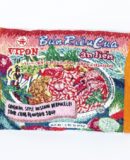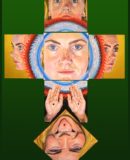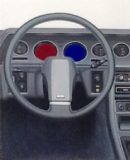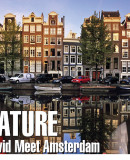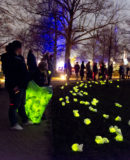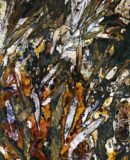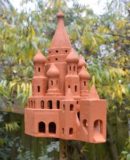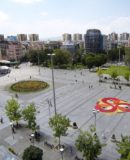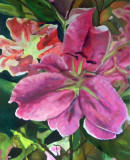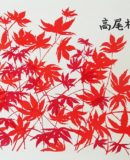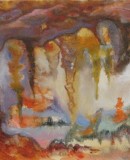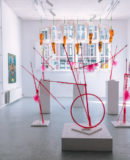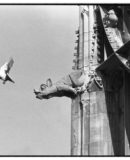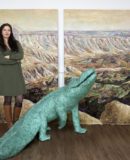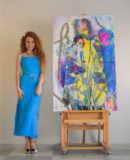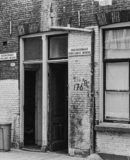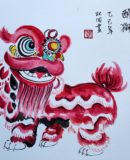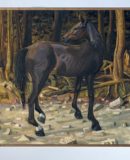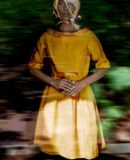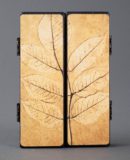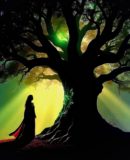World Artists and their Story, 1 – Carl Giskes
World Artists and their Story, 1 – Carl Giskes
We speak in Carl Giskes’ workspace in the Tierrafino factory in the Amsterdam port area. The room is pretty empty. On the walls there are clay painted squares with different shades. In between a work of a bison that Giskes made in straight lines, also in clay paint.
In all the spaces of the Tierrafino factory there werer many bisons to be seen. The Bison Caravan is a traveling exhibition, initiated in 2003 by artist Hilarius Hofstede. Form Aarhus it went to Marseille, Bamako / Mali and Poland.
After Amsterdam it will go to Canada and Brasil. At every stop the exposition grows. There was a wonderful opening in Amsterdam with a concert by the Malian singer / guitarist Samba Touré.
Der Bonzenbunker
Carl Giskes is owner of a factory that makes a special product: clay plaster and clay paint. He also is an artist. Asked for the central theme in his work he says: ‘It has to do with what does not yet exist, at least as far as I know. Sometimes there is something ‘in the air’, then someone on the other side of the globe is doing the same thing. You often see things simultaneously occur.’
He shows me his plan for his next work of art. We walk out of the office into the factory. In the back on the right I see a square building of rammed earth (layers packed earth of different colors). At the two corners there are narrow elongated windows with wide borders around it. It looks like a bunker and it is a bunker, Der Bonzenbunker, inspired by the eponymous bunker of Joseph Beuys (1921 – 1986).
Giskes: ‘I pick the ugliest corner of a space and I’m going to make something of it. It’s intuition. I am involved in designing homes and buildings, especially commercial buildings. There is the 1% regulation, where 1% of the construction costs is intended for art. I often take part in that. In this way I designed the Enschede Tax Office and the Rijkswaterstaat (the state authority in water affairs) building in Rhoon.
Djenné (Mali) The product Giskes developed, clay paint and clay plaster, is a natural product, extracted from deeper strata of European clay and sand soils. Clay paints and clay plasters have many positive effects. They radiate peace and quiet, purify the air and refresh people’s energy. ‘There are already 100 companies that imitate our products. Our clients are often artists, but we also deliver to many shops, a hundred, at home and abroad.’In 1977 Giskes came back from a seven-year journey through Africa, where he saw mud houses. He gazed at the town of Djenné (Mali) in great admiration. In 1981 Giskes started in Germany ( he is from Krefeld) plastering houses with clay plaster. ‘We had made white, yellow and red clay.’ Demand was growing and he started a production company in 1992.
Frisian village Hallum
In 1986 he came up in the Netherlands. ‘That was because of Louwrien Wijers, I met her in Germany in 1981. She had written books about Beuys, Andy Warhol, the Dalai Lama and other artists. ‘Do you know a good craftsman?’ she had asked Beuys. She wanted to remodel a house near the Frisian village Hallum for the Tibetan lama Geshela. The house had to be rebuilt in Tibetan style, with Tibetan furniture and bedsteads. For two years Giskes worked on it. ‘We had no electricity and all the material we withdrew from demolition.’
With Louwrien Wijers Giskes organized in the late ‘80s the congress Art meets Science and Spirituality in a changing Economy at the Stedelijk Museum and the Fodor Museum. It consisted of a series of discussions with panels of a scientist, an economist, an artist and a spiritual person.
There were well-known and famous people on it. A number of Nobel Prize winners and David Bohm, Ilya Prigogine, Fritjof Capra, the Dalai Lama, Robert Rauschenberg, John Cage, Marina Abramovic and others. In the Fodor Museum, which now no longer exists, Carl Giskes built a pavilion in the garden, the Adobe Pavilion, made of clay. ‘There are books written about that conference.’
Oibibio
Meanwhile, he had met his future wife Catherine, who was a student of medicine. They had four children together.
After the conference – it is now 1993 – he came into contact with Ronald Jan Heijn. He built with him the multicultural spiritual center Oibibio at Amsterdam Prins Hendrikkade. ‘For every rooom we made models. Then it was painted with clay plaster and clay paint. It got very artistic. I worked a lot with Jacobus Kloppenburg and Waldo Bien. It was a big job.’ The center turned seven years and then went bankrupt. ‘What do you want? 150 staff persons.’
Thomas Rau
After this Giskes happened to meet Thomas Rau, a famous architect, also of German origin, who had an architectural office in Amsterdam. The cooperation with Rau soon had good results. ‘Just do residential construction’ Rau said. Many buildings were designed: three town houses, Culemborg, Middelburg and Zutphen, a tax office, a court, a building of the Triodos Bank.
‘Always artistic, I was hired for that, after all.’ The icing on the cake that this period ended, was the shaping of the pavilion of the World Expo 2000 in Hannover. ‘A large pavilion. It was the last building where I was involved as an artist / executive builder.’
Since 2001 he focuses himself entirely on the manufacture of ready made products. There were many new products. Further he works in projects as a consultant. ‘Not as a performer anymore. Thats is too intensive. It takes a lot of energy, you have to be constantly alert. In Oibibio he experienced that a subcontractor started to work of the stairwell with gypsum and he with employees on the top with clay. ‘It was the beginning of the holiday. Luckily I could correct it by phone from a distance.’
Super Gallery
His factory space is also ‘super-gallery’. Now the walls are filled with bisons. The exhibition Bison Caravan started in 2003 in the Modern Art Museum Aarhus. After the attacks in 2001 on the World Trade Centre in New York the world got locked, it seemed. A group of artists led by Hilarius Hofstede felt the need for a powerful movement that would connect cultures with each other.
The image of the bison came up because it was representing our own European prehistory and the roots of the visual arts: the paleolithic cave and the first paintings by human hand. The combination of the ancient building material together with the ancient clay paintings in te caves, and the bison, an animal from prehistoric times, appealed highly to Carl. The decision to exhibit in Amsterdam was taken quickly.
100 copies
The next major exhibition in the factory, at the end of the year, is about Joseph Beuys’ artwork Der Bonzenbunker. ‘Beuys made this work for me, I was his assistent. On an A4, he drew two mountains. In one of those mountains, he drew an elevator, which went down deep into the mountain. Then he drew a large room, a bunker. That bunker exists in real life, in the Eiffel.’
Then he ordered to make 100 copies of that drawing. For every copy he wrote a sentence, usually something political, such as Genscher’s letzten Wohnort. Genscher was then foreign minister. These drawings are hung in the exhibition at Tierrafino.
‘The exhibition space will be plastered with clay. The bunker is part of the exhibition. Beuys felt that art had to give pleasure. He brought art to the people. He lived frugally and he wanted the price of his works cheap. 50 Marks for a drawing. After he had sold them he had 5.000 Marks in his pocket. Now those A4 pages are worth 10 to 20.000 euro each. Beuys became famous and his works are scattered throughout the world.’
Carl Giskes
Seven basalt columns
Carl got to know Beuys in 1977. ‘I just came back from my seven-year world trip. A friend of mine who lived in a ‘common home’ in Düsseldorf / Krefeld, Bernd Jansen, had his room furnished in Beuys’style. Half a year later – I was working with natural stone, did sculpture – I had rented a factory. I invited Beuys to give a lecture there. He did not come himself, but sent his secretary, Johannes Stüttgen.’
‘Johannes told Beuys what I was doing. Not much later, I received an invitation to come at his desk. He was working on the Skulpturenpark am Seestern, a large park in Düsseldorf. Beuys lived nearby. He asked me: ‘Can you do things for me?’ He wanted to plant 7.000 oak trees in Kassel. Next to those trees he wanted to plant basalt columns. Could I deliver seven basalt columns at his place?’
‘The next day he called me. ‘Can you bring 70 columns?’ The day after he called again. ‘Can you bring 700 columns?’ And after ‘Can you bring 7.000 columns?’ Ultimately all the columns were delivered. It took three months. The basalt, from the core of ancient vulcanoes in the Eiffel and Westerwald, came form three groves. Every stone was 6 – 700 kilo’s, some were up to 100 kilo’s. They were loaded onto a trailer with a crane.’
‘Then I got the request from Beuys to drill a hole in 72 stones in the shape of a large flower pot.’Carl gets a book and I see the pictures of the holes in the columns. ‘After drilling it had to be honed and then the piece of stone went back into the column. Beuys had a constant toothache and as a remedy he used comfrey, Symphytum officinale. For each column he also made a Symphytum, a paste that went into the drilled hole. Then, when the stone was put back, also the stone could be ‘healed’. The entire project was named Das Ende des 20.
Jahrhunderts.’
In addition to each of the 7.000 trees a column was planted. ‘In this way you could give time a role. Coming twenty years later, the column is small and the tree big. It’s still there. The whole city of Kassel is full with it. Every third tree in Kassel is a Beuys’tree. It started in 1982 and five years later, in 1987, the last tree was planted. This coincided with the opening of Dokumenta 8 1987.’
Beuys’ students
‘Beuys was an art professor at the Düsseldorf Art Academy. He was a teacher throughout his life, but he was fired. However, he was allowed to keep his room at the Academy. With Klaus Staeck he founded the Free International University (FIU). A few years later, in 1986, he deceased.
Carl learned a lot from Beuys. ‘He wanted to do something for others. He brought others to succes. That’s a strong aspect of Beuys. Many of his students are now famous artists: Gerhard Richter, Waldo Bien, Walter Dahn, Blinky Palermo. All students of Beuys who became big.’
http://www.tierrafino.nl/biografie.html
Disclaimer: The views, opinions and positions expressed within this guest article are those of the author Walter van Teeffelen alone and do not represent those of the Marbella Marbella website. The accuracy, completeness and validity of any statements made within this article are not guaranteed. We accept no liability for any errors, omissions or representations. The copyright of this content belongs to Walter van Teeffelen and any liability with regards to infringement of intellectual property rights remains with the author.

